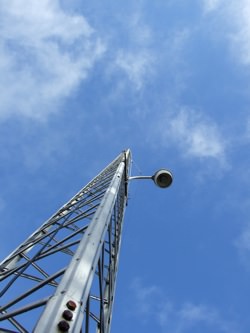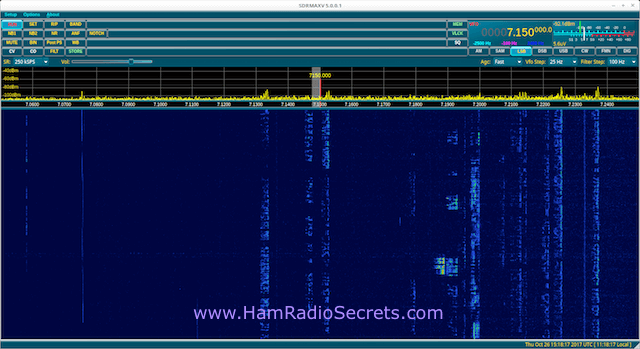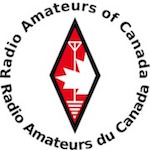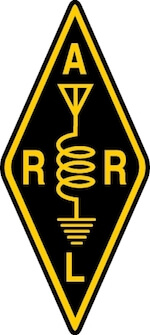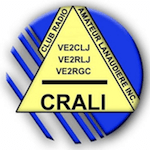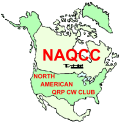Ham Radio
Tower Guide
The selection and installation of a ham radio tower must be planned carefully.
When you do your homework properly, the tower will give you many decades of safe and reliable service.
My 15 meter (48 feet) free-standing, heavy-duty tower has been up since 1977!
It was dismantled and re-assembled once, in 1987, when we moved to the country, from the suburbs of Montréal (QC, Canada).
It still stands proudly (and safely) after more than 30 years of service.
Notice I do not have a beam on top. I just use it as one of the
supports for my Carolina Windom 80 and for my 160 meter inverted-L. Not visible on the photo is my 2 meter vertical antenna sitting on top of the tower.
Essential Considerations
First ensure that your local town authorities allow ham radio towers where you live! If the answer is yes, you are a lucky ham radio operator!
Armed with a copy of the local bylaws and ordinances, you will then be able to proceed to the next step. The selection.
Here are the first essential limitations to consider.
- Your tower must not be installed where it could fall on power lines.
- You must take steps to prevent children from climbing the tower (i.e. a locked fence around the base).
- You should not install a tower where it could fall on the neighbor's property.
Further
Practical Considerations
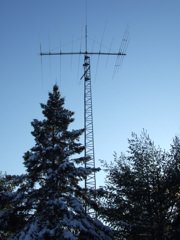 Large Yagi Atop HD Tower
Large Yagi Atop HD Tower- Local climate (max winds, freezing rain in particular).
- Antenna wind load (present and future).
The tower should be sturdy enough to withstand the wind load that the size and weight of the antenna(s) will impose on the tower.
You may only be able to afford a small HF yagi tri-bander now ... but you will eventually want add a multi-element VHF yagi, a UHF yagi and/or a larger multi-element HF yagi!
You can either buy/install a heavy-duty tower now, or plan to replace your first light duty tower in a few years ... because you will want to put up more antennas in the future! Trust me ;-)
If this is your first tower, you should ask for the opinion of other hams in your neighborhood and local club. They will supply priceless advice ... and likely even help you put the tower up!
Ham Radio Tower
Types
There are four main types of towers. Each type has its specific installation requirements. Many are available in light, medium or heavy duty.
- Guyed. In terms of "cost per foot", the guyed tower is the most economical. However, you must have enough space for the guy wires!Guy anchors
should be installed away from the base of the tower at a distance of
between 60% to 80% of the tower height. (Follow the manufacturer's
instructions).
- Free-standing. Moderately expensive. They have a "lean" impact on the visual environment.
- Fold-over or tilting (hinged base and/or hinged sections).They
are more expensive, but very practical if you want to be able to work
on your antennas without having to climb the tower to do so!
- Crank-up (hand-crank or motor driven). This is the most expensive of all but ... oh! so practical!
When you buy a new tower,
the manufacturer will normally supply detailed installation instructions.
Follow them to a "T"!
Click Here To View
A list of tower manufacturers for ham radio.
(Web page)
Final Recommendation
Before buying a used ham radio tower, inspect it for rust (or paint covered rust!) and wind damage (warped).
This is when you most definitely should have a few experienced hams to help you with the selection and installation.
73 de VE2DPE
Claude Jollet
7, Rue de la Rive, Notre-Dame-des-Prairies, Québec, Canada J6E 1M9
QTH Locator: FN36gb
Disclosure
If
you make a purchase via a link on this site, I may receive a small
commission on the transaction, at no extra cost to you. Thank you!


(One word queries work best)
HF Antennas
Section
Contents
VHF/UHF Antennas
FOUND THIS
SITE
USEFUL?
VE2DPE
Is a member
in good standing
of
Also a proud member of an international community of solopreneurs
using SoloBuildIt!
(SBI!)
to promote my self-published eBooks
since 2005.
See my review
of this unique product for online businesses.
CQ CQ CQ
If you have a question, a comment or a topic you would like me to cover, please do not hesitate to ask here.
